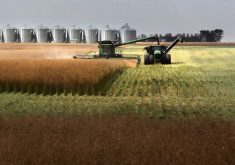Just two days after the release of the latest statistics on household food insecurity in Canada, Agriculture and Agri-Food Minister Marie-Claude Bibeau announced a new phase of the Local Food Infrastructure Fund.
Launched in 2019 as part of Canada’s food policy, this program funds infrastructure and equipment for local food charity programs and is the only federal program naming food insecurity reduction as part of its goal.
This approach to addressing food insecurity is deeply misguided.
Read Also

Why agriculture is Canada’s energy ace
Why isn’t agriculture getting more play in Canada’s quest for efficient, renewable energy production? It should be
At a time when food insecurity affects almost one in five Canadians, the latest funding presumes that food-insecure households are accessing food charities and that doing so resolves their food insecurity.
Both assumptions are simply untrue. The problem is too big and, despite their best efforts, food charities can only provide limited emergency support.
Prime Minister Justin Trudeau described the program as part of fulfilling the government’s priority of “making life more affordable for Canadians.” Bibeau described it as “designed to strengthen our local food systems and support the creation of more food banks, community gardens and collective kitchens.”
Yet Canada’s massive and ever-expanding network of charitable food assistance programs can’t even keep the problem in check, let alone reduce or prevent it.
The 2022 statistics show that 6.9 million people in the 10 provinces, including almost 1.8 million children, lived in households struggling to afford the food they need. That’s more than four times the number of visits food banks receive.
Seeking food charity is a strategy of desperation for food-insecure Canadians, mostly by those who are severely food insecure. There’s no evidence to indicate that food charity prevents severe food insecurity or resolves it.
Will buying more refrigerators for community programs—presumably to help handle the ever-expanding donations of ‘food waste’ from major grocery chains and food processors—truly change this?
The latest call for applications to the Local Food Infrastructure Fund is even more disturbing when we consider its place as a centrepiece of Canada’s food policy.
The policy’s ambitious vision that “all people in Canada are able to access a sufficient amount of safe, nutritious and culturally diverse food” seemed commendable when first announced.
But the vision being implemented through the Local Food Infrastructure Fund now is a two-tiered food system. Affluent Canadians purchase premium products at supermarkets, farmers markets and designer food outlets, while millions of others line up to receive rations from volunteers working feverishly to distribute food rejected from that retail system.
The direction of our national food policy is a sharp departure from the understanding of food insecurity reflected in “Opportunity for All,” a document produced by the federal government under its poverty reduction strategy.
The first pillar of that landmark document is “dignity,” and living with dignity means having enough income to meet basic needs.
Food insecurity is identified as a key indicator of poverty and is tracked to measure our progress in poverty reduction. Unfortunately, food insecurity reduction has never been adopted as an explicit objective of the policies led by Employment and Social Development Canada, and so the problem has festered.
Federal income supports are critical policy levers to reduce food insecurity in Canada, but this objective needs to be incorporated into how those income supports are designed.
Despite the federal government’s repeated celebration of the Canada Child Benefit’s success in reducing child poverty rates from 2016-19, almost one in four children in the 10 provinces were living in food-insecure families in 2022 – more than ever before.
Redesigning the Canada Child Benefit to provide more money to the lowest-income households would help reduce food insecurity among families with children.
The Canada Workers Benefit and Employment Insurance are the two federal programs that support the incomes of workers in Canada and also have the potential to impact food insecurity rates.
Most food-insecure households rely on employment income. This means having a job is not enough for many Canadians to meet basic needs. It also tells us that our existing supports for low-wage workers and those experiencing job loss are insufficient to bridge the gap.
The federal grocery rebate, while too small and short-lived to impact the alarming rates of food insecurity in Canada, is a step in the right direction.
By giving much-needed cash directly to low-income Canadians, the rebate reflects the principles of dignity and inclusion so clearly articulated in the Poverty Reduction Strategy. By comparison, the latest call for funding applications for the Local Food Infrastructure Fund is a big step backward.
Although the policy levers needed to address food insecurity lie outside of Agriculture and Agri-Food Canada, the food policy was an opportunity to establish interdepartmental collaboration with Employment and Social Development Canada to chart an action plan aimed at reducing food insecurity and begin making progress toward this goal.
Unfortunately, none of this came to fruition.
The food policy is slated for renewal later this year, which could be a chance for a course correction.
– Valerie Tarasuk is with the Department of Nutritional Sciences at the University of Toronto and Tim Li is a Research Program Coordinator, Food Insecurity, at the University of Toronto. This article first appeared in the Conversation, by Reuters.















